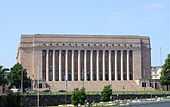Parliament House, Helsinki
| Parliament House | |
|---|---|
|
Eduskuntatalo Riksdagshuset | |
 | |
| General information | |
| Type | Governmental |
| Location |
|
| Coordinates | 60°10′21″N 024°56′00″E / 60.17250°N 24.93333°ECoordinates: 60°10′21″N 024°56′00″E / 60.17250°N 24.93333°E |
| Construction started | 1926 |
| Completed | 7 March 1931 |
| Design and construction | |
| Architect | Johan Sigfrid Sirén |
Parliament House (Finnish: Eduskuntatalo, Swedish: Riksdagshuset) is the seat of the Parliament of Finland. It is located in the Finnish capital of Helsinki, in the district of Töölö.
History
In 1923 a competition was held to choose a site for a new Parliament House. Arkadianmäki, a hill beside what is now Mannerheimintie, was chosen as the best site.
The architectural competition which was held in 1924 was won by the firm of Borg–Sirén–Åberg with a proposal called Oratoribus (Latin for "for the speakers"). Johan Sigfrid Sirén (1889–1961), who was mainly responsible for preparing the proposal, was given the task of designing Parliament House. The building was constructed 1926–1931 and was officially inaugurated on March 7, 1931. Ever since then, and especially during the Winter War and Continuation War, it has been the scene of many key moments in the nation's political life.
Architecture and features

Sirén designed Parliament House in an architectural style combining Neoclassicism with early twentieth century modernism. Sirén's combination of simplified columns and balusters with simplified planar geometry bears comparison to similar explorations by Erik Gunnar Asplund and Jože Plečnik. The exterior is red Kalvola granite. The façade is lined by fourteen columns with Corinthian capitals.
The building has five floors, each of which is unique. The floors are connected by a white marble staircase and famous paternoster lifts. Most important for visitors are the main lobby, the stately Session Hall and the large Hall of State.
Notable later additions to the building are the library annex completed in 1978 and a separate office block, the Pikkuparlamentti (English: Little Parliament), the necessity of which was an object of some controversy, completed in 2004.
First floor
The first floor contains the main lobby, the Speaker’s reception rooms, the newspaper room, the Information Service, the Documents Office, the messenger centre, the copying room, and the restaurant and separate function rooms. At both ends of the lobby are marble staircases leading up to the fifth floor.
Second floor
The second or main floor is centred around the Session Hall. Its galleries have seats for the public, the media and diplomats. Also located on this floor are the Hall of State, the Speaker’s Corridor, the Government’s Corridor, the cafeteria and adjacent function rooms.
Third floor
The third floor includes facilities for the Information Unit and the media and provides direct access to the press gallery overlooking the Session Hall. The Minutes Office and a number of committee rooms are also located here.
Fourth floor
The fourth floor is reserved for committees. Its largest rooms are the Grand Committee Room and the Finance Committee Room.
Fifth floor
The fifth floor contains meeting rooms and offices for the parliamentary groups. Additional offices for the parliamentary groups are located on the sixth floor, along with facilities for the media.
Sightseeing
Guided tours are arranged on Saturdays at 11:00 and 12:30 and on Sundays at 12:00 and 13:30; in July and August also at 14:00 on weekdays. Tuesdays and Fridays you can watch the Parliament in session from the public balcony.
External links
| Wikimedia Commons has media related to Parliament House, Helsinki. |
- Parliament House brochure
- Official website of the Finnish Parliament
- Information about Parliament House on wcities
- Short movie featuring Parliament House
| ||||||||||||||||||||||
